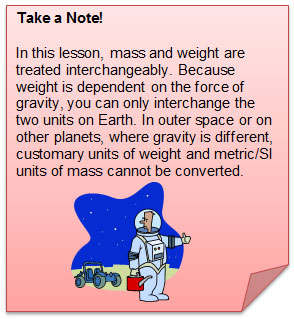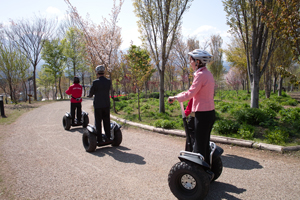
Another common conversion between measurement systems deals with mass and weight. Mass is the amount of matter that an object contains, and weight is the force exerted on this amount of matter by gravity. Customary units describe an object’s weight, and metric/SI units describe an object’s mass. Weight and mass conversions occur in fields such as medicine, construction, and shipping, especially since these fields tend to cross international boundaries quite frequently. In order to convert between systems, you must first identify key units of measurement for mass and weight in each measurement system.
Copy the table below into your notes.
Fill in the chart below for customary units. Click on the blanks to check your answers.
| 1 pound = | Interactive button. Assistance may be required. _________ 16 ounces |
| 1 ton = | _________ 2000 pounds |
Copy the table below into your notes.
Fill in the chart below for metric units. Click on the blanks to check your answers.
| 1 gram = | Interactive button. Assistance may be required. _________ 1000 milligrams |
| 1 kilogram = | _________ 1000 grams |

There are two important conversion facts that can be used to convert mass and weight between systems: 1 pound (lb) = 454 grams (g) and 1 kilogram (kg) = 2.2 pounds (lbs).

Source: Ferrari 458 Italia, Aurélien Vialatte, Wikimedia
To use these facts in a problem situation, consider the following report.
In September 2009, the car manufacturer Ferrari introduced the Ferrari 458 Italia sports car. The engineering and specifications of this machine were impressive to sports car fans, but since it was a European model, its mass is reported as 1,485 kg. What is the weight of this sports car in pounds?
First, make a plan for converting the units from kilograms to pounds.
Interactive popup. Assistance may be required.
to see a possible answer.
Use dimensional analysis to convert kilograms to pounds.


![]() Click on the image below to access the applet. Use the applet to perform dimensional analysis in order to perform the conversion.
Click on the image below to access the applet. Use the applet to perform dimensional analysis in order to perform the conversion.
Why is it important to be able to convert weight in pounds to mass in kilograms or vice versa?


Source: Segway Tour, toooooool, Wikimedia